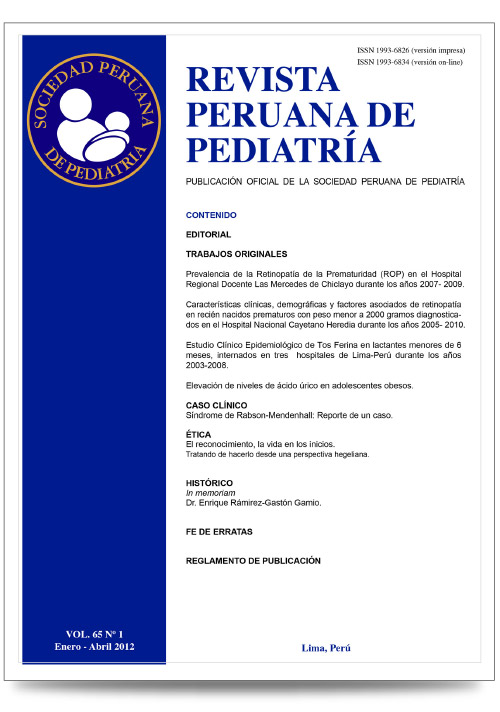Elevated uric acid levels in obese adolescents
DOI:
https://doi.org/10.61651/rped.2012v65n1p33-37Keywords:
Uric Acid, Pediatric Obesity, AdolescentAbstract
Objectives: To determine the frequency of elevated uric acid levels in obese adolescents aged 10 to 17 years and their relationship with metabolics characteristics.
Materials and methods: We performed a descriptive study. It included 115 obese adolescents aged 10 to 17 years attending the service of Endocrinology at the Arzobispo Loayza Hospital which met the inclusion criteria. Was defined as elevated uric acid levels> 5.5 mg / dl. It took data on age, sex, weight, height, body mass index (BMI), blood pressure, glucose, HDL, LDL, triglycerides, total cholesterol and alanine aminotransferase. The value of p <0.05 was considered significant.
Results: The 33.9% of patients had uric acid levels above 5.5 mg /dl. 54.8% (63 patients) were male. The median age was 13 ± 2 years. Acanthosis nigricans and abdominal obesity were the most common features on physical examination of these patients with 87% and 97% respectively. Relationship was obtained with age (p <0.02) male sex (p<0.001), family history of diabetes (p<0.03), abdominal circumference (p<0.001), weight (p<0.001) and BMI (p<0.001).
Conclusions: These results suggest that uric acid levels are significantly increased in obese adolescents and is related to sex, body mass index, waist circumference and blood pressure.
Downloads
Downloads
Published
How to Cite
Issue
Section
Categories
License

This work is licensed under a Creative Commons Attribution 4.0 International License.
Authors will retain the copyright and grant the right to publish their work in the journal while allowing third parties to share it under the Creative Commons Attribution license.
Articles are published under a Creative Commons license that allows sharing and adaptation with appropriate credit. CC BY 4.0 license. Available in English at https://creativecommons.org/licenses/by/4.0/
Authors may use other information disclosure formats as long as the initial publication in the journal is cited. The dissemination of the work through the Internet is recommended to increase citations and promote academic exchanges.
The published content does not necessarily reflect the specific point of view of the journal, and the authors assume full responsibility for the content of their article.




